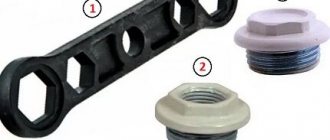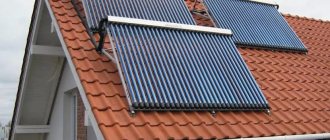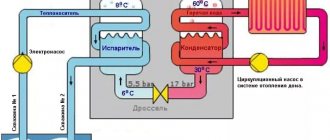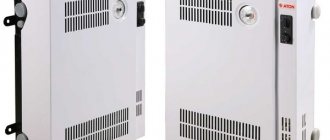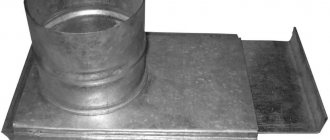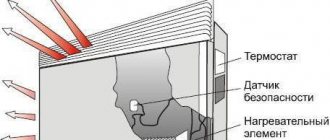Here you will learn:
- What is convection
- Advantages and disadvantages of convector heating
- Types of convectors
When planning to create heating in our home, we want it to be economical and efficient. Convector heating has precisely these characteristics - it is based on convectors powered by bottled or main gas, water systems or an electrical outlet. Let's see what convectors are, how they work and how they differ from each other. We will also look at the main features of convector heating of residential premises.
Comparison of oil and convector heaters
If you decide to choose convector heaters, it is important to consider the pros and cons of the device even before going to the store.
Such devices differ from oil devices in the shape of the body, which is smooth and flat. Oil units, as a rule, are located on the floor, which distinguishes them from convector units. If desired, you can even install baseboard convectors, the height of which can be 15 centimeters, the length starts from 1500 cm. If you cannot decide whether to choose a convector or an oil heater, which is better of these two devices - the information presented in the article will allow you to understand
Oil units are usually located on the floor, which distinguishes them from convector units. If desired, you can even install baseboard convectors, the height of which can be 15 centimeters, the length starts from 1500 cm. If you cannot decide whether to choose a convector or an oil heater, which is better of these two devices, the information presented in the article will help you understand.
The devices can be compared with each other in terms of cost-effectiveness of use. The oil type consumes 1/4 more electricity compared to the convector type. Due to the fact that electricity tariffs are constantly rising, this factor may be decisive when purchasing a device. The warm-up period is also quite important. With the help of an oil heater this happens in several stages. First, electricity helps heat the heating element, which heats the oil, the latter transfers heat to the fins of the housing. This process can take quite a long time and consumes a certain amount of electricity. Thus, consumers note that after turning on the equipment, the room does not immediately become warm. Fans built into the oil heater can speed up this process. If we are talking about a convector, then it instantly begins to heat the air, and the efficiency is 95%. The heating rate is not so high; an oil radiator, which is equipped with a fan, outperforms a convector under additional conditions.
Types of convector heating systems
Now, once and for all, without any registrations or SMS, you can download 1xBet for Android for free by clicking on the active link and continue to enjoy the game and place bets on your favorite team in a convenient mobile application.
A convector heating system can be:
- Electric. Electric current is used to heat the heating elements, and the electric convector itself is connected to an alternating current network.
- Water. Such devices have pipes installed inside which a coolant liquid (water or antifreeze) circulates. Water convectors are connected to centralized heating networks, and when heating a frame private house - to an autonomous heating system.
- Gas. In this case, special gas units are used. Heating in a wooden house with gas convectors can be organized using main or bottled fuel.
Let's look at the characteristics and features of each type of convector heating at home.
Gas convectors
Such devices can operate on liquefied or main fuel. To connect to the gas mains, you need the appropriate permits from the gas service. No permits are required to use bottled gas.
The gas convector uses the following operating principle:
- A gas burner is installed in the combustion chamber, where fuel combustion occurs. As a result, a large amount of thermal energy is released.
- From this heat, the body of the device heats up and begins to release temperature to the air in the room. At this moment, the principle of convection begins to work, when warm air masses rise to the top of the room, and cold currents pass to replace them.
Such heating devices have not gained much popularity due to their bulky size and complex connections, as well as a low degree of fire safety. As a result of fuel combustion, combustion products are formed that need to be removed. For this purpose, the device is equipped with a coaxial chimney. To take this pipe outside the house, you need to make a hole of a suitable diameter in the wall near the device.
Water convectors
The classic option for heating a house is to use a water convector. Such devices can be used in a private house or apartment. For them to work, you need to lay pipelines, install a heating device and connect batteries. In centralized systems, it is enough to connect the devices to the apartment circuit.
These units use water or antifreeze as the coolant. In autonomous systems, a gas, electric or solid fuel boiler is installed to heat the coolant. The type of fuel is selected depending on the availability of resources in a particular region.
After connecting the devices to the heating circuit, the heated coolant transfers heat to the metal surfaces of the radiator, from which the air circulating in the room is heated.
To regulate the temperature in the room, thermostats and control valves are installed on the devices. This can also be done by controlling the operation of the heating boiler. To bleed air from the devices, a special valve is installed on each of them.
Electric convectors
Such units are convenient, easy to use and install. To organize heating of a frame house with convectors, it is enough to buy and connect the devices to an alternating current network. The units can be installed on the floor or hung on the wall. In the latter case, brackets are pre-attached to vertical surfaces.
Advantages of using electric convectors:
- Easy installation. All work can be done within half an hour and done with your own hands.
- There is no coolant circulating in the device, which could leak or cause corrosion. For the same reason, the unit is not afraid of freezing.
- Electric convectors are often mobile, so they can be installed anywhere and, if necessary, moved to another room.
- The operation of the electric convector is controlled automatically. Electronic or mechanical control systems allow you to maintain the desired temperature in the room.
- Some units have thermostats, so when a certain air temperature in the room is reached, they automatically turn off, and when this indicator drops below a set threshold, they turn on again.
The main disadvantage of convector electric heating is that you will have to pay a significant amount for heating even a small country house, because electricity is not a cheap type of fuel.
Power calculation
If a convector is needed only as an additional source of heat - for periods of extreme cold - it makes sense to take a couple of low-power devices - 1-1.5 kW each. They can be moved to those rooms where the temperature needs to be raised. If convector heating is the only source of heat, everything is much more serious.
This is approximately how you can calculate the power of convectors
If you do everything “wisely,” you need to calculate the heat loss of a house or apartment and select equipment based on the calculation results. In fact, this is very rarely done. Much more often they calculate the required heating power by area: 10 square meters for heating. m area requires 12 kW of heat. But these are the norms for average ceiling heights - 2.50-2.70 m and average insulation. If the ceilings are higher (the volume of air needs to be heated) or there is “no” insulation at all, the power is increased by 20-30%.
Installation in a private house
The ease of installation of electric convectors allows you to implement this procedure yourself.
Before you make convector heating with your own hands, you need to prepare the following tools:
- Hammer.
- Screwdriver.
- Hammer.
- Level.
A wall-mounted electric convector is installed in the following sequence of operations:
- Assembling the device, during which it is necessary to secure all the brackets to the body.
- Fitting the structure to the wall surface: it must be leveled. During this, marks are made at the location of the brackets.
- The brackets must be removed from the panel and attached one by one to the applied markings. This makes it possible to mark points for drilling holes for fasteners.
- Using a hammer drill, holes are made in the marked places.
- Using a hammer, carefully hammer the dowels into the base.
- To screw the brackets, use a screwdriver or screwdriver.
- The instrument panel is hung on well-fixed brackets.
- To start operating the convector, it must be connected to the network.
When using electrical appliances, it is important to understand that such convector heating of the house will significantly increase the load on the network, so you should calculate in advance whether the old wiring will withstand this. To ensure heating safety, it is recommended to equip devices of this type with separate cable lines. https://www.youtube.com/embed/WZnvggq6oWI
Useful additional features
When choosing electric heating convectors, pay attention not only to technical parameters. There are also additional functions that increase comfort and safety:
- Overheat protection. An additional sensor is installed on the case, which turns off the power when a threshold value is reached. Usually it is +60°C.
- Drop shutdown. This function is relevant for models with floor-mounted installation. If the position changes (falls or bends too much), the power turns off. This function prevents possible fires.
- Restart. When turned on again, the electric convector automatically sets the settings that were when it was turned off.
Skirting-type convector - very low and long
Overheat protection and drop shutdown are very useful features that increase the safety of the equipment. Something else you can pay attention to is how quiet or loud the unit is. It's not just the heating element (it usually clicks). When activated, the mechanical thermostat also clicks. When choosing convection heaters for your bedroom, quiet operation is very important.
Operating principle of the convector
According to the laws of physics, cold air is heavier, so it is at the bottom.
The principle of convection is to pick up cold air masses from below, heat them inside the unit and move them to the top, from where warm air is blown upward.
This is how the room is heated. The flow moves continuously, so within 3 - 4 minutes the room becomes warm. Then the air masses cool again and fall down, where they again fall into the lower openings of the convector.
As can be seen from the figure, the operating principle of an electric convector and its design are quite simple.
It consists of:
- body made of metal;
- heating element (heating element);
- various sensors (temperature, convector position, overheating sensor);
- control panels;
- thermostat;
- gratings.
The body is usually made of light alloy metal. It performs a protective function and is made lightweight specifically to reduce the weight of the product. Two gratings are inserted into it. One of them is located below. Through this hole, cold air is sucked in by the convector. The second is located in front of the heater in its upper part. Already heated air exits through it.
Air can enter the electric heater either naturally (convection, when air rises when heated) or forced. Fans are often installed in devices to increase the air supply, thereby increasing the efficiency of the convector. This operating principle of convector heaters reduces the load on the heat exchanger, which increases the reliability and durability of the device.
The temperature sensor is installed in the lower part of the heater. Typically, it takes a temperature measurement every 45 seconds, after which a signal with the result is sent to the control unit, where the electronic thermostat turns the device on or off (depending on the sensor readings).
Types of heating elements
The heart of the convector is the heating element. Electric models typically use three types of heating elements:
- monolithic;
- tubular with aluminum fins;
- needle.
It is recommended to install models with a monolithic heating element in the bedroom, as they do not make any sounds and will not interfere with rest.
A special feature of a heater with a monolithic heating element is its noiselessness. In this case, the body is made solid (cast). The heat loss of this device is minimal, so it has a high efficiency rate.
In the case of a tubular heating element, the heating element is a steel tube in which a nichrome thread is stretched, and the internal space is filled with insulating backfill (heat-conducting). Fins made of aluminum are fixed to the tube, which provides the device with high heat transfer and increases the degree of convection. Heaters of this type have a long service life and can be installed in the bathroom, but sometimes they make a cracking noise.
Needle heating elements consist of a dielectric thin plate on which a heating chrome-nickel filament coated with insulating varnish is installed. Convectors with such a heating element heat up and cool down almost instantly, but they should not be used in rooms with high humidity levels. The main advantage of devices with needle heating elements is their affordable price, but they cannot be called durable.
Convector electrical circuit
As can be seen from the figure, the circuit of electric heaters of this type is quite simple.
It is enough to connect the device to a 220 V network using a cord, then press the switch button (it completely disconnects the device from the electrical network, so you don’t have to remove the plug, but use the button). The control panel is usually a temperature controller. Also included in the circuit is a safety sensor that opens the circuit when overheated, and a thermostat that turns the convector off or on depending on the ambient temperature.
Main varieties
Various energy sources can be used to operate convection heating in a private home, but most household devices of this type are equipped with electric heaters. There are also gas convectors that run on gas. The great popularity of electric models for heating rooms is explained by their compact dimensions. In cases where convective heating plays the role of the main one (which often happens in country houses and dachas), it is more profitable to use gas modifications, because gas is much cheaper.
Based on the installation method, convectors are:
- Floor-standing
. Designed for floor placement. Some models are equipped with special wheels for mobility. In other cases, a rigid installation is used, without the possibility of movement. - Wall mounted
. They are hung on the walls of the room, for which the product kit includes the appropriate fasteners. - Built into the floor or baseboard. This installation principle allows you to save living space.
Let's sum it up
Assessing the features of convector heating devices, we can conclude that most models will be a suitable solution for a country house. Moreover, it does not matter whether the dacha is a substantial country house or a small building for rare visits.
It is important to eliminate all sources of heat loss and take care of insulation of walls and floors. If you plan to use the device as the only source of heating, its failure in the winter threatens to disrupt your plans or vacation. Considering that country houses are usually located far from city limits, preference should be given to reliable convector models. The priority will be the presence of a monolithic heating element, a mechanical thermostat and a durable housing.
Convector device
To organize convective exchange, it is necessary to use a convector. This device can operate using both natural and forced circulation. Modern convectors for heating a home can be of different designs, but they are based on three main elements:
- a heat exchanger or heating element that acts as a heat source;
- casing;
- a convection chamber with louvers or valves (it is designed to direct air flow).
Convector device
Additional elements may include devices for adjusting the direction of warm and cold air flows, as well as an automated control system.
Types of heating elements
The heating element performs the main function of a convector heater. There are three types of heaters in total:
- Needle (ribbon) elements are the most short-lived, but affordable.
- Tubular heaters represent the optimal combination of price and quality; the only drawback of this type of heater is the characteristic clicking sound when heating up.
- Monolithic elements are a modern development, they are silent and reliable, but they are somewhat more expensive than shadow or tape heating elements (for more details, see the article types of heating elements in convectors).
Monolithic heater
Self-installation
You can install gas equipment in a private home with your own hands, but to do this you need to have all the necessary tools and have certain skills.
The following materials and tools are used during the work:
- metal-plastic pipe with fittings;
- pipe cutter;
- wrench;
- sanitary silicone;
- gas tap;
- perforator with a “spatula” crown;
- drill with drill bit;
- crosshead screwdriver;
- high-temperature polyurethane foam and silicone;
- dowels and screws made of plastic.
Stages of installation work:
- First you need to decide where the gas appliance will be installed. According to GOST, it is mounted under the window.
- The convector is fitted to the selected location. You can use a tape measure and transfer the dimensions, or simply attach the unit to the wall and mark the locations of future holes.
- Let's look at where the gas inlet is located. If at the bottom of the device, then you need to leave enough space for the supply of a pipe with a fitting.
- A hole is punched in the wall along the diameter of the exhaust pipe. This can be done with a hammer drill. This procedure is not only labor-intensive, but also dusty, so it is recommended to cover things with film in advance.
- Holes are drilled and dowels are hammered into them.
- The exhaust pipe is inserted into the convector. The joint should be treated with high-temperature silicone. After the pipe is inserted into the wall, the convector is secured using self-tapping screws.
- A gap is sealed between the pipe and the wall. This can be done conveniently using high-temperature foam.
- A special cap, included in the package, is installed at the end of the pipe. It prevents the burner from going out due to wind. Self-tapping screws are used to secure it.
Procedure for gas supply:
- The pipe leading to the heating device must be laid outside. This is the requirement of GOST. If the gas pipe already has a threaded connection, then just screw the tap onto it and shut off the gas supply to the convector. If there is no withdrawal, then one will have to be made. To perform this work, it is necessary to invite an electric and gas welder.
- After installing the gas tap, a metal-plastic pipe is connected to the convector. You can calculate its length using a tape measure.
- When laying the pipe, every meter should be secured with clips, for which you will need to drill holes in the wall.
- Installed fittings, like pipes, are lubricated with silicone, which provides additional sealing and facilitates installation work.
Now you need to check how the equipment works by doing a test run:
- The gas valve is opened and a soap solution is applied to all fittings and connections. Inflating bubbles will indicate a leak. If any are found, the tap should be turned off and the problem fixed.
- Next, the convector starts up. The gas supply button is pressed for about a minute, during which the gas will pass through all the pipes and end up in the combustion chamber.
- The piezo igniter is pressed, causing a spark to form in the firebox and ignite a flame.
- The device is adjusted so that the room temperature is comfortable.
At first after starting, you may notice an unpleasant smell of burning oil. This is normal - this is how the camera burns on new devices. If the smell persists for a long time, you need to check the quality of the joint between the exhaust pipe and the outlet of the device.



